Decorating Magnolia Tree For Christmas
Once you've seen a magnolia tree, no way you can forget its stunning flowers and their sweet lemony fragrance. If you dream of having a magnolia to grace your garden, this guide will teach you everything you need to know about the different types of magnolia trees and which you should choose depending on the available space and the climate you live in. Get started now!
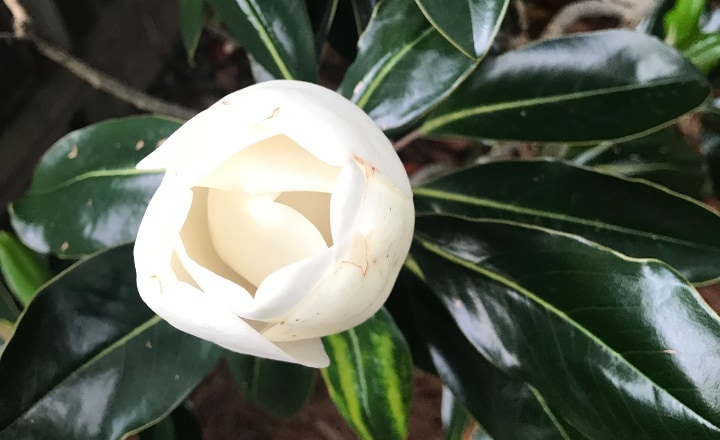
Magnolia these trees may look delicate from a distance, but they are truly resilient. In fact, they are older than just about any other flowering plants on Earth.
We'll show you how and when to plant a magnolia, as well as how to care for it. The best part about magnolias is they're rather sturdy and do not require much care.
Planting and caring for a magnolia tree is a wonderful experience. So you might as well get it right!
Magnolia Tree Facts
Are magnolias evergreen or deciduous? And how tall can they grow?
Before we dive deeper into how to grow a magnolia tree and magnolia tree care tips, first some interesting facts.
Magnolia trees are so old there were no bees around when they first appeared, so they had to rely on beetles for pollination. To be more appealing to beetles, the flowers produce large quantities of pollen, rather than nectar.
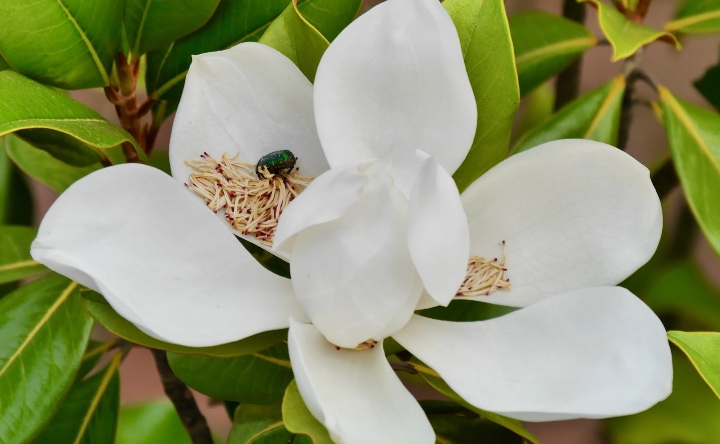
The tree bears the name of the French botanist Pierre Magnol, who grouped plants with similar features and invented the concept of plant families we still use today.
Evergreen vs Deciduous
There are two types of magnolia trees:
- Deciduous trees lose their leaves every winter
- Evergreen magnolias retain their petals all year round
As a general rule, magnolias that flower before the leaves unfurl are deciduous. One reason to cultivate a deciduous magnolia is that the absence of leaves better showcases the flowers.
Height
As to height, different species of magnolia trees can range in size from 15 to 80 feet in height and reach widths of up to 40 feet.
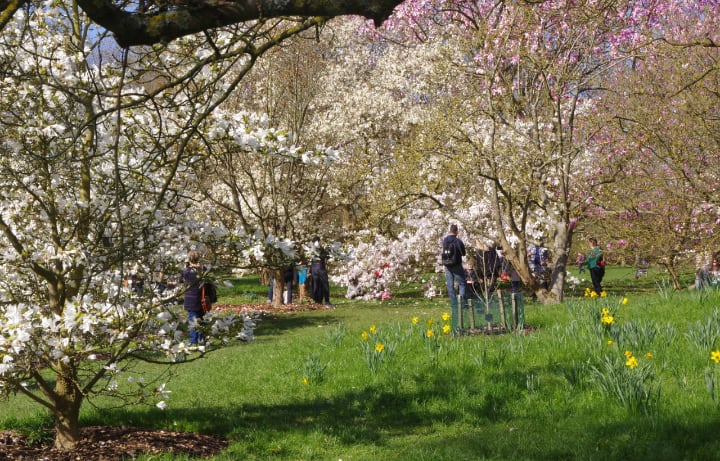
This means that stacking four of the tallest male giraffes on Earth one over the other would still not exceed in height the tallest magnolia tree!
Age
We've already seen that magnolia trees are very old. But to get a better idea of just how old they are, consider this—the magnolia genus is thought to have appeared before the oldest known fossil bees.
Did you know: Scientists believe magnolia trees are the oldest flowering plants in the world.
Archaeologists have unearthed magnolia fossils dating back over 100 million years, which means dinosaurs got to enjoy these beautiful flowers. Maybe even munch on them?
Magnolia Tree Leaves
People love magnolias for their flowers, but magnolia leaves are interesting in themselves.
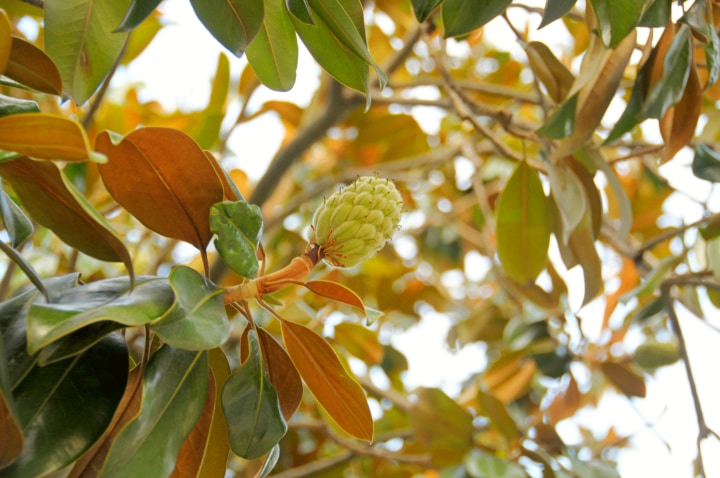
Dark green and oval-shaped, magnolia leaves have a waxy layer made of a kind of fatty acid that helps the tree repel pollutants and retain water.
They are arranged alternatively on branches and have a leathery texture.
Magnolia Tree Flower
Beautiful from a distance, a magnolia tree offers a more intimate spectacle if you zoom in on one of its flowers.
Magnolia flowers don't have petals in the classic sense, and bees are not all that crazy about them. But come late spring or summer, magnolias become some of the most beautiful plants on earth.
Magnolia flowers come in a variety of colors: white, yellow, pinkish, purple and even green. Some are only 1.5 inches wide, while others grow up to 12 inches. Talk about variation!
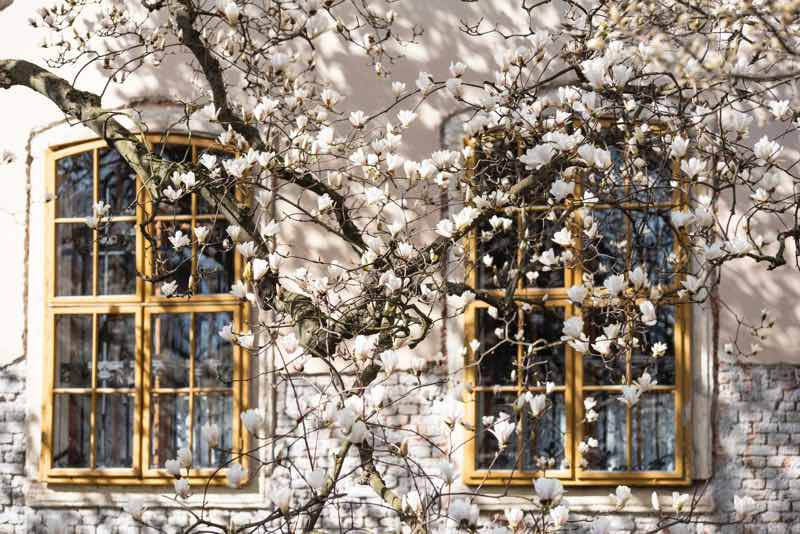
The flower has up to 18 tepals, which are petals and sepals fused together. Most magnolias trees bloom before their leaves unfurl and can be star-shaped or saucer-like.
Magnolia tepals have a leathery texture. But depending on the variety, magnolia flowers can have a waxy or smooth texture.
They're harder than most flower petals, most likely to prevent withstanding damage from the beetles that feed on their pollen.
When Do Magnolia Trees Bloom?
On deciduous type magnolia trees, the flowers appear in early spring, before the leaves.
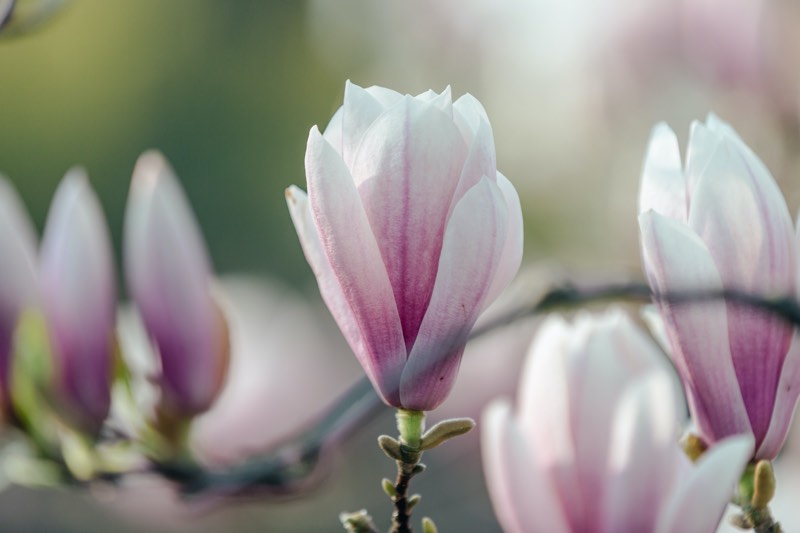
Evergreen magnolias bloom in late spring or early summer, but it's not uncommon for them to bloom again in early autumn.
Magnolia Flower Meaning
If you've decided to buy and plant a magnolia in your backyard, you might be curious about what this tree 'stands' for.
People have loved magnolias for thousands of years. They have attached quite a few meanings to these amazing flowers.
The long history of the genus, together with its remarkable adaptability and its tough carpels, which have evolved to prevent damage from pollinating bees, make it a powerful symbol of endurance, long life, eternity, and dignity.

Like all exquisite flowers, the magnolia also symbolizes beauty. Magnolia flowers are large and bloom boldly so that they also stand for magnificence.
Giving magnolias to a woman is a way of acknowledging her dignity and nobility.
Other meanings of the magnolia include self-respect, strength of character, eternity, and life force. No wonder then that magnolias are popular for weddings and birth ceremonies as a sign of endurance and love.
The Meaning of Different Magnolia Colors
You are probably familiar with white and pink magnolia flowers already, but the magnolia tree can wear a few other colors, too. Let's look at the symbolism of each.
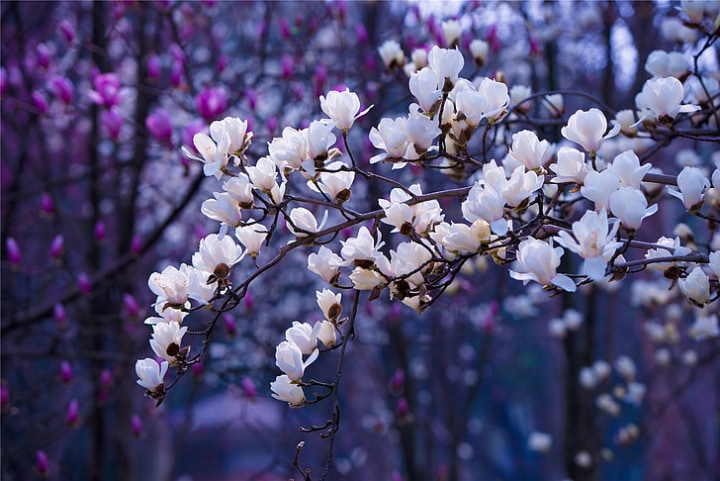
- White magnolias symbolize perfection, purity, and eternity.
- Pink magnolias convey joy, innocence, and youth.
- Green magnolias symbolize luck, health, and joy.
- Purple magnolias stand for dignity and luck.
The Meaning of Magnolia Flowers in Different Countries
Loved around the world, magnolia flowers carry a special meaning in some countries. The Chinese cherish the "jade orchid" or magnolia denudata, which is usually pure to creamy white but can also be yellow or pink.
Symbolizing purity and nobility, the magnolia denudata reinforces the sentiments expressed by the one who offers it as a gift.
In ancient China, magnolias were a symbol of female beauty. They are also associated with the Yin, the feminine side of life.
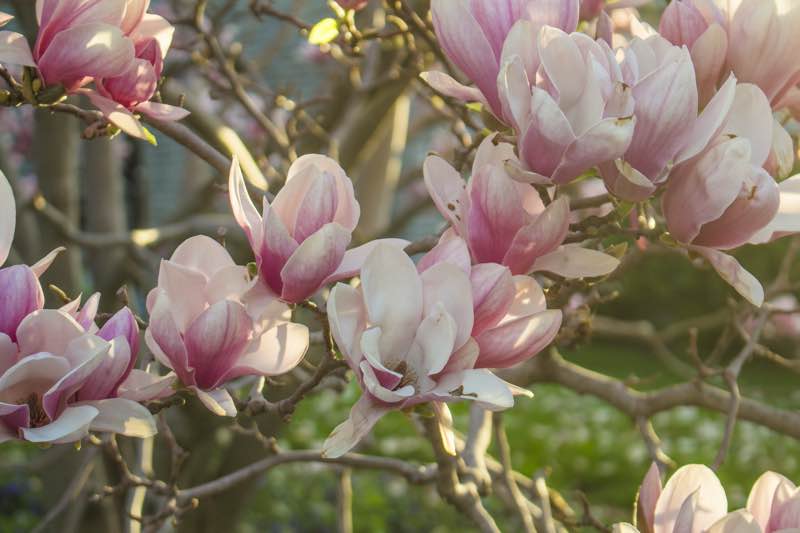
The Japanese associate magnolia flowers with a love of nature and the sublime. They use the magnolia not only as an ornamental plant but also as a medicinal one.
Across the globe, in the United States, the magnolia is the official state tree of Mississippi, which is also called the Magnolia State.
Texas, on the other hand, has its own Magnolia City—Houston—so named for the magnolia trees growing on the banks of the Buffalo Bayou river. Closely associated with the South, the magnolia is a herald of spring in the US.
In England, magnolia flowers carry further meanings of dignity, nobility, and pride, some of which have been inherited from Victorian times.
Popular Types of Magnolia Trees
There are about 210 types of magnolia trees that grow all over the world, from Asia to North and South America. The trees vary widely in size, so it's quite easy to find one species that fits perfectly into your garden.
The smaller species grow 15 ft tall, while the larger ones reach up to 80 ft tall and 40 ft wide. You need a really big garden for this one.
Fact: Magnolia 'Atlas' boasts the biggest flowers, which can measure up to 14 inches in diameter.
Let's have a quick look at some of the most popular types of magnolia trees.
1. Magnolia Jane Tree
Jane Magnolia is a shr ub-like tre e that grows up to 15 feet tall and 10 feet wide at maturity. The tree blooms in spring and again over the summer.
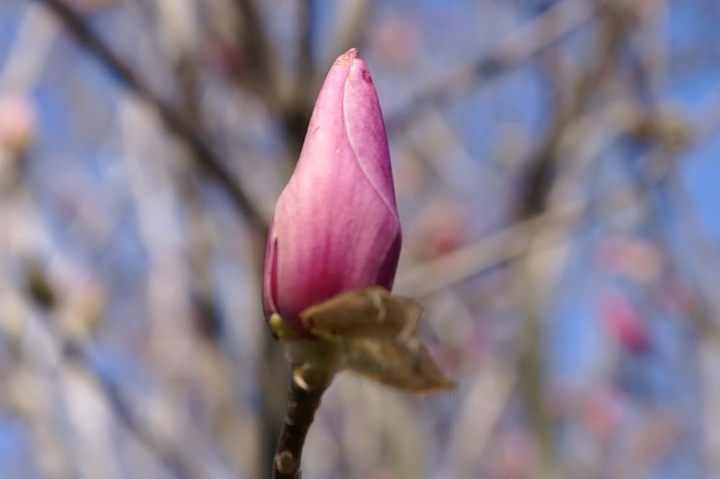
Don't worry if your Jane magnolia shows no sign of blooming while other garden flowers are already in bloom. That's normal.
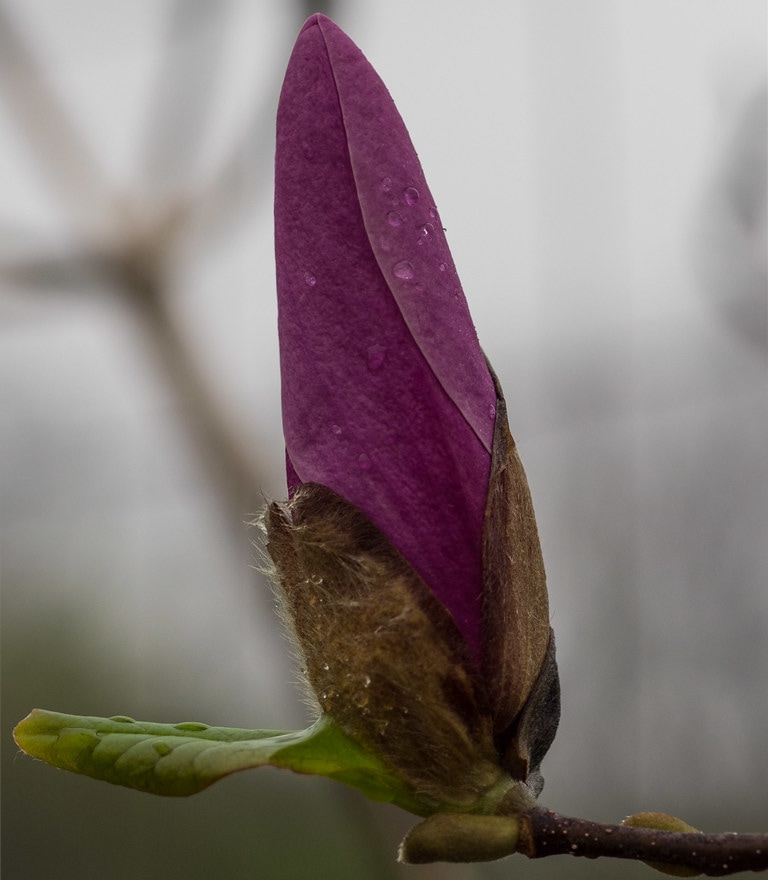
Jane magnolias generally bloom a couple of weeks later than other species, but their delicate pink flowers will last for a month.
2. Magnolia Soulangea Tree
The shape of the Saucer magnolia's white-and-pink blooms gives it its name. Left unpruned, it can grow into a tall, rounded shrub with more than one stems.
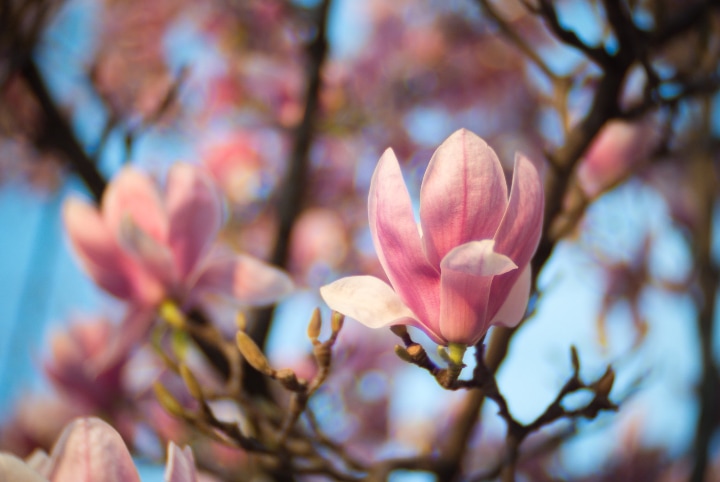
Also known as Saucer Magnolia, this is one of the most popular types of magnolia. The shrub grows 20-25 ft tall and 20-25 ft wide. Typically flowers in March, but this depends on the climate in your area.
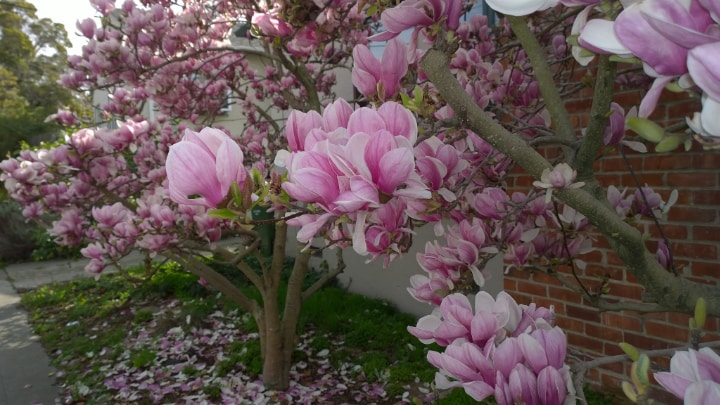
Tip: Late frosts can easily damage its flowers. Also, it's best to plant Saucer Magnolias in an area protected from strong winds.
Flowers can vary in color from completely white to white with pink to dark pink hues.
3. Magnolia Stellata Tree
The Star magnolia blooms into star-shaped white flowers in early spring, making it an early bloomer, and a charming one at that. It's a deciduous, medium-height magnolia.
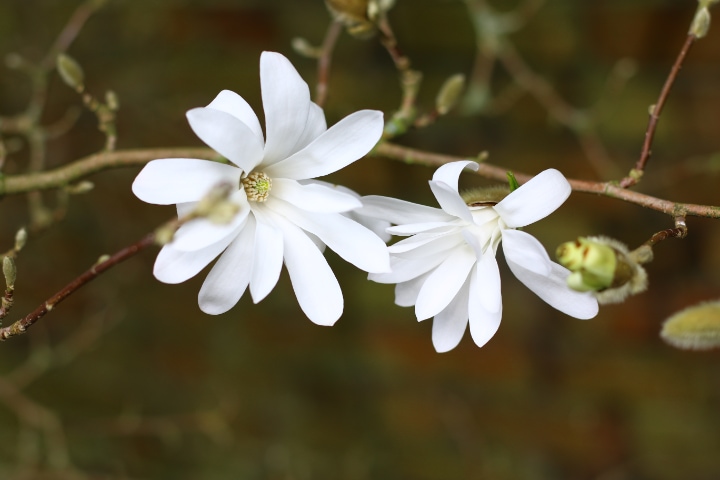
Magnolia Stellata or Star Magnolia is ideal for small gardens, as it only grows up to 6 ft tall with a 6 ft spread. What it lacks in size, it compensates in beauty with a mass of bright white star-shaped flowers.
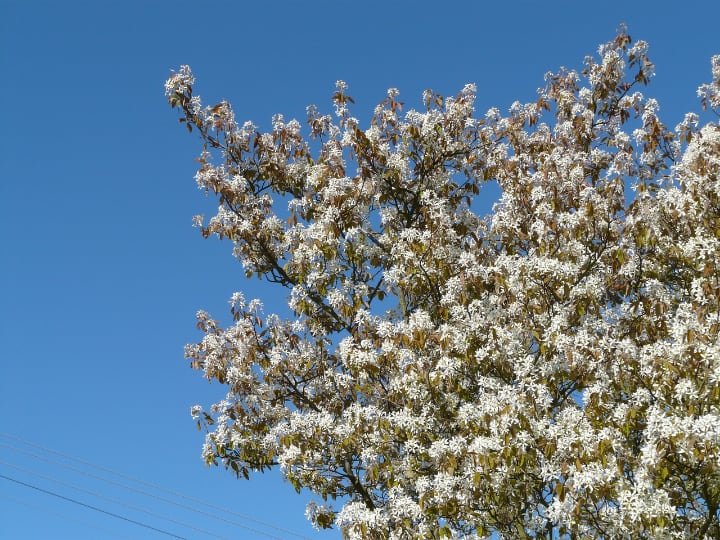
Although it's rather small, this shrub doesn't do so well when crowded by other plants, so it's best to provide enough space for it to grow. Magnolia Stellata blooms in early spring, March or April.
4. Ann Magnolia Tree
Ann Magnolia reaches up to 8-10 ft tall and wide, which makes it a perfect choice for a small garden. This tree blooms a bit later than other magnolia types so it's protected from spring frosts.
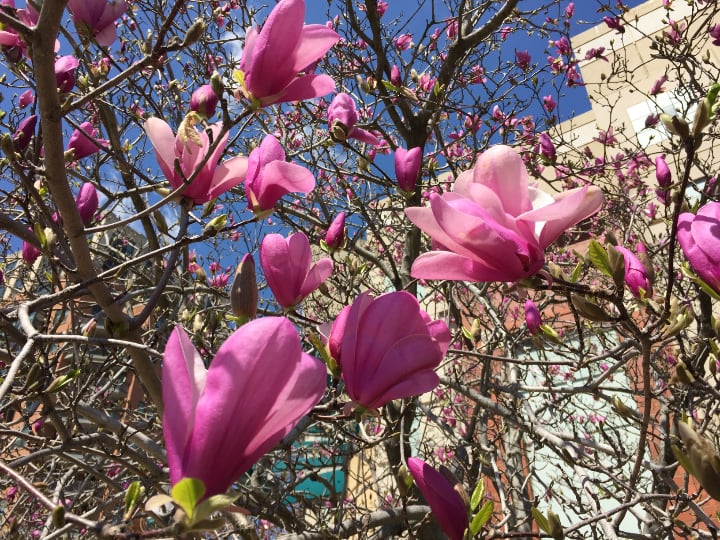
It was created in the 1950s, as a cross between Magnolia Stellata and Magnolia Nigra by two breeders who were looking for a late-flowering magnolia.
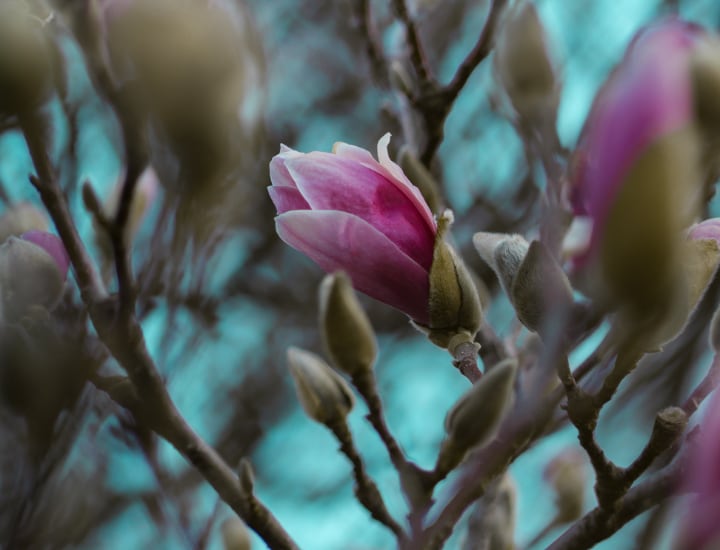
It has large flowers, up to 9 inches long, that rise like goblets from the branches.
5. Lily Magnolia
Lily Magnolia is one of the smaller magnolias, as the trees only reach up to 8-10 ft at maturity.
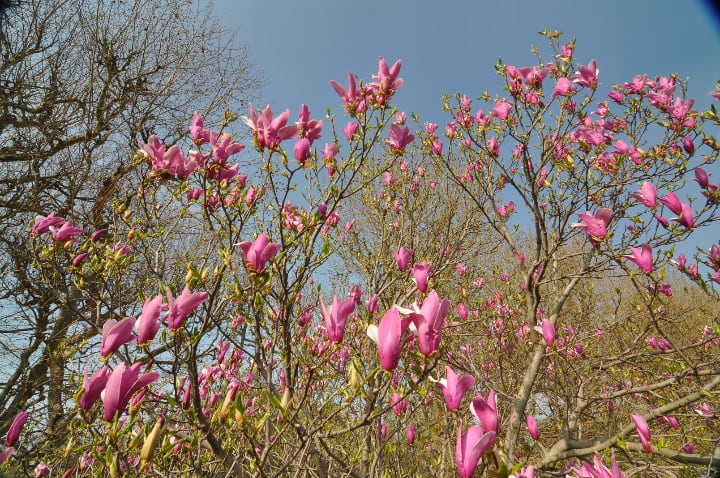
The stunning beauty of its lily-shaped pink or reddish-purple flowers makes it a good candidate for the focal point of your garden, but you can also see this shrub in hedges.
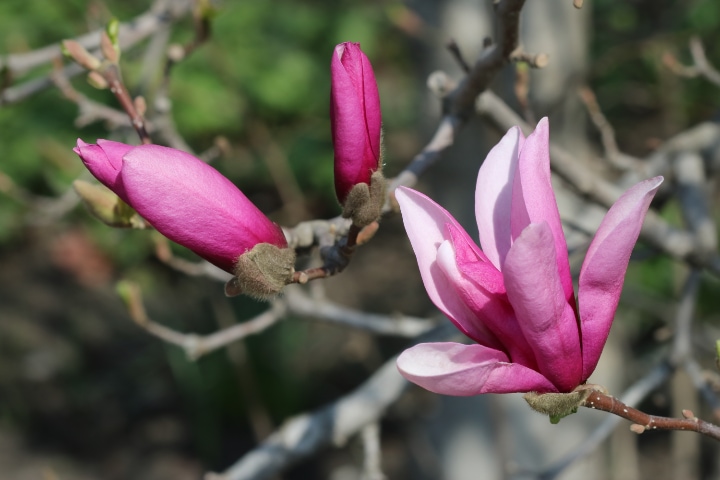
Tip: A very popular cultivar of this species is Magnolia liliflora 'Nigra', known for its dark purple flowers.
6. Butterfly Magnolia Tree
A rare type of yellow magnolias with tulip-like flowers, the Butterfly Magnolia is a single trunk shrub that reaches up to 20 ft in height. It's a sturdy plant that thrives even in cooler areas.
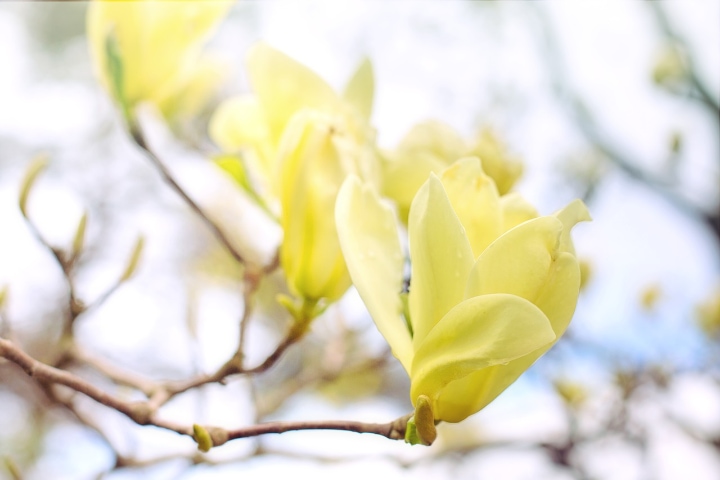
In warm areas, the Butterfly Magnolia can bloom as early as February. Although it was created in the 1980s, it's still quite rare, which makes it even more special.
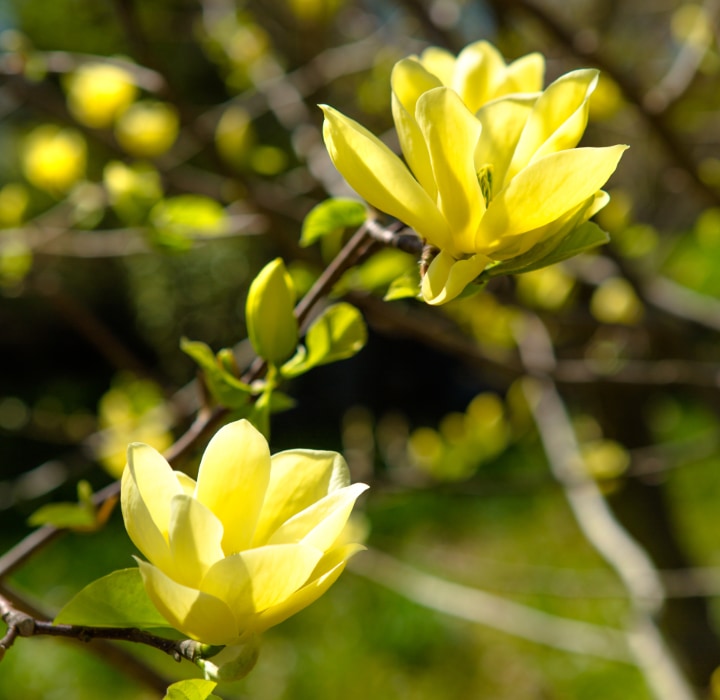
7. Sweetbay Magnolia Tree
Usually a deciduous plant but possibly an evergreen in warm climes, the Sweetbay Magnolia tree doesn't mind boggy soil.
Sweetbay Magnolias grow up to 50 ft in warm southern climates, while in a cooler area it rarely exceeds 30 feet.
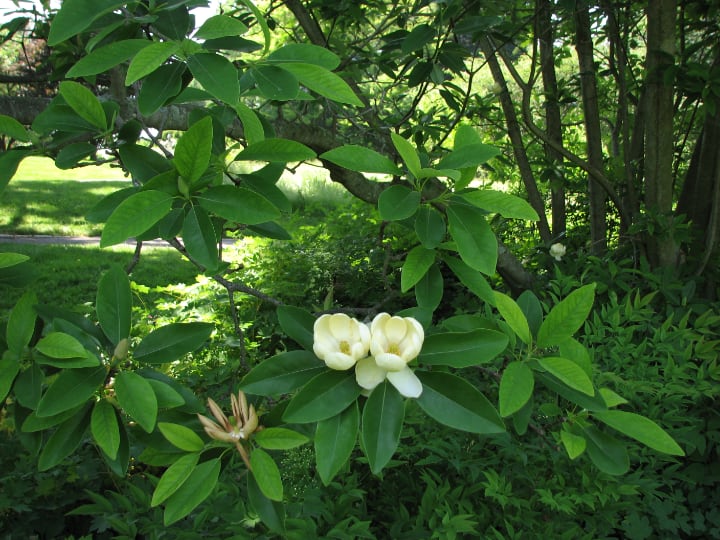
This type of magnolia blooms rather late, May or even June, so it escapes spring frosts. Its creamy-white flowers have a strong lemony scent.
The red fruit of the Sweetbay Magnolia tree attracts a variety of gray squirrels, turkey, and quail, as well as numerous songbirds, such as towhees, Northern flicker, and blue jays.
Tip: Plant in moist, acidic soil. Mix some leaf mold (humus) into the soil when planting.
8. Teddy Bear Magnolia Tree
As opposed to many crown-shaped magnolias, the Teddy Bear Magnolia is compact and tall-growing. It sort of looks like a bear, hence the name.
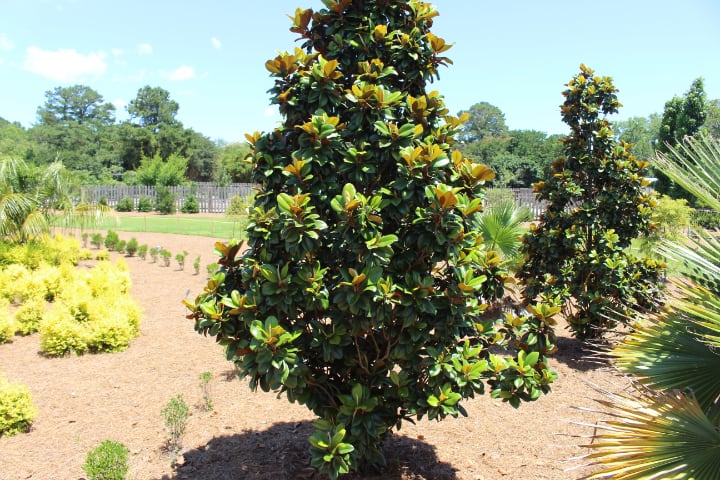
It's an evergreen type of magnolia, which makes it perfect for an informal hedge around your property. The tree grows up to 16 ft tall.
From May to October, the Teddy Bear Magnolia produces fragrant white saucer-shaped flowers that are 8 inches wide.
9. Little Gem Magnolia Tree
Little Gem Magnolia is an evergreen that grows to a height of 15–20 ft and a spread of 7–10 ft. Thrives in warm regions and is best planted in full sun.
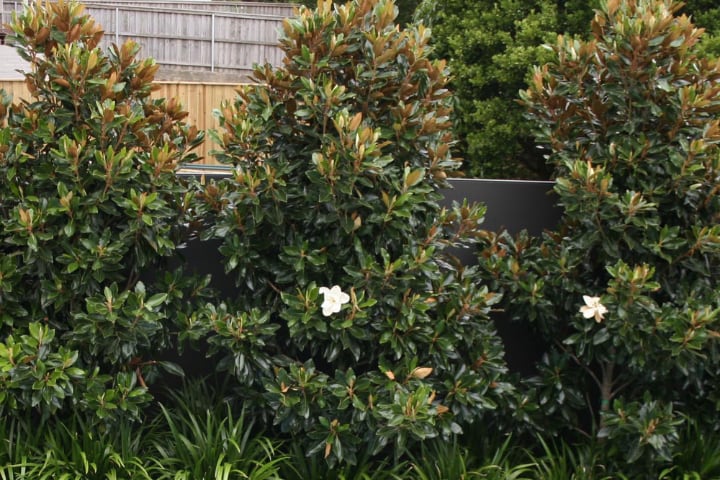
Good to know: Besides its more manageable size, what makes Little Gem so popular is the fact that it's an early bloomer so you will have creamy-white flowers in your garden for more than half a year.
10. Anise Magnolia Tree
A deciduous tree, the Anise magnolia blooms into beautiful white flowers that turn a golden yellow by fall.
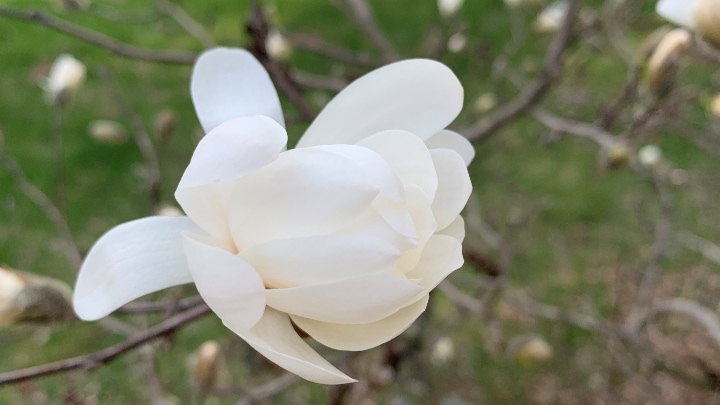
It grows in full sun to partial shade and can reach up to 30' in height.
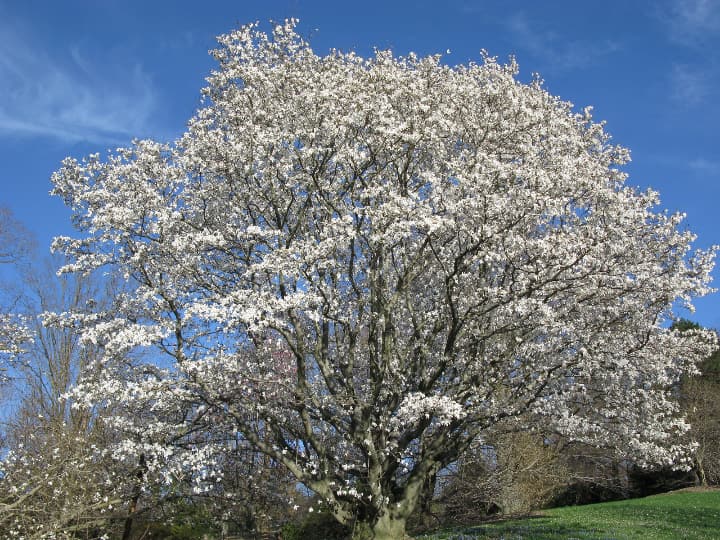
11. Loebner Magnolia
The Loebner Magnolia is a cross between the Star Magnolia and Kobus Magnolia. It's a small-sized type that grows up to 20-30 feet tall. The tree usually has several stems, but you can prune them into a central leader.
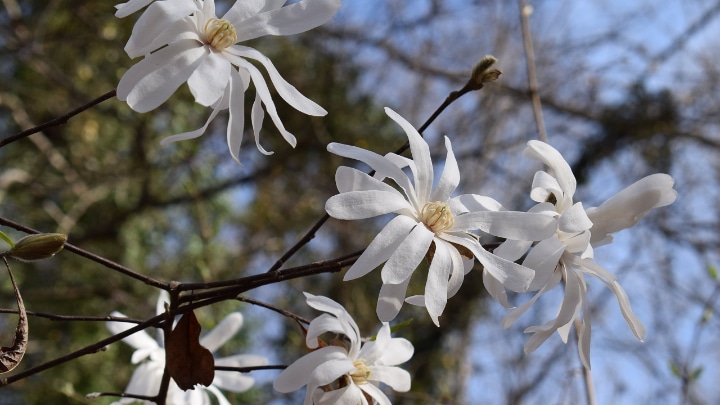
Fragrant star-shaped pink and white flowers 4-6 inches wide appear in spring before the foliage emerges. The dark green oval leaves are smaller than with other magnolias, no more than 5 inches long.
12. Susan Magnolia Tree
A compact type of tree, Susan Magnolia reaches up to 10 ft tall and 6 ft in width. It belongs to the 'Little Girl' group of magnolias, like the Ann type, all designed to bloom in late spring to avoid frosts.
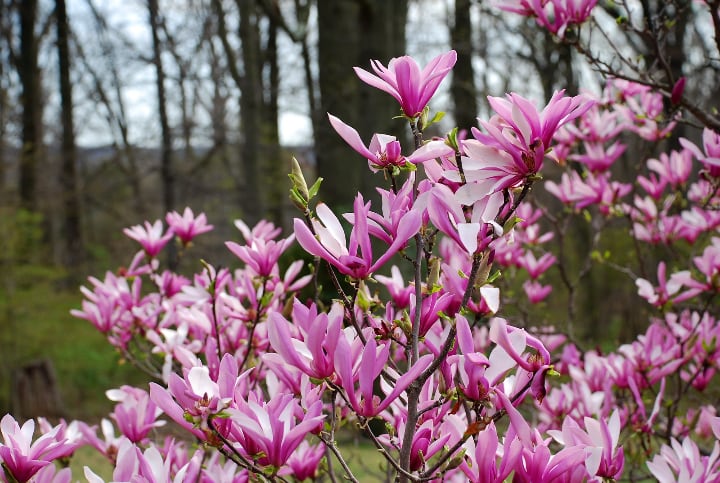
The striking fuchsia flowers sometimes make a second appearance in late summer. Grows best in a location protected from strong winds.
13. Royal Star Magnolia Tree
The Royal Star Magnolia is a cultivar of the Magnolia Stellata. Its snowy white flowers are larger than the star-shaped flowers of the Stellata type and reach up to 5 inches across.
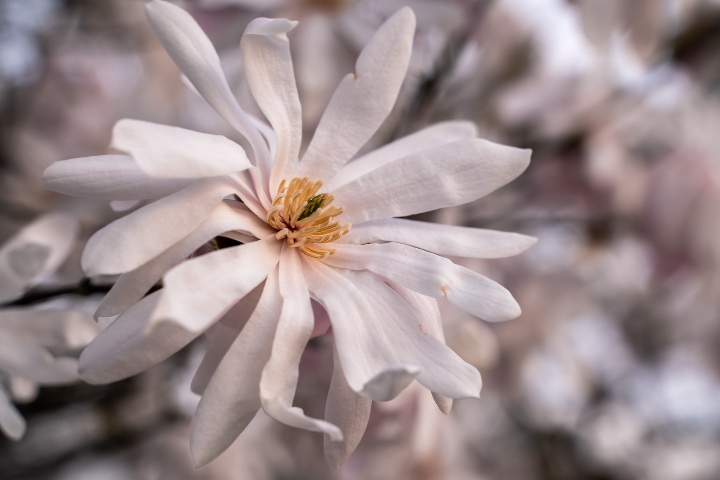
Tip: Royal Star shines when viewed against a dark background. Plant it in front of a stand of deep green arborvitae or a dark brick wall.
You should plant the tree in a sheltered location, protected from strong cold winds. The wood is rather weak—heavy snows or ice can easily damage it.
14. Japanese Magnolia Tree
Also known as Kobus Magnolia, the Japanese Magnolia is a medium-sized tree that can grow up to 30-40 ft when it reaches maturity.
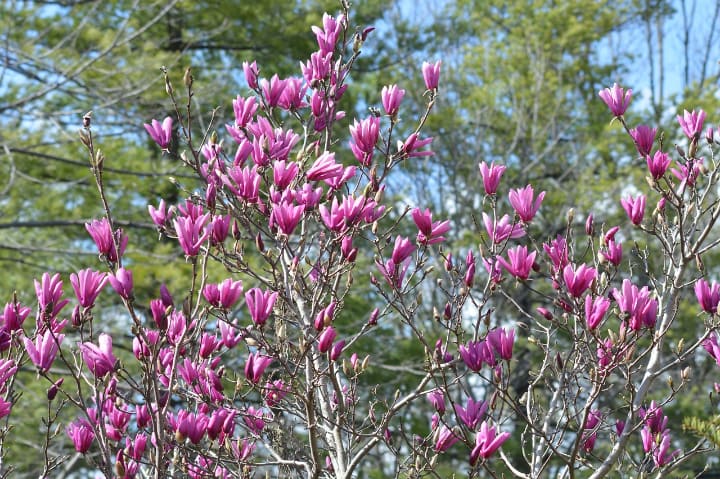
Its white flowers tinged with pink bloom in early spring.
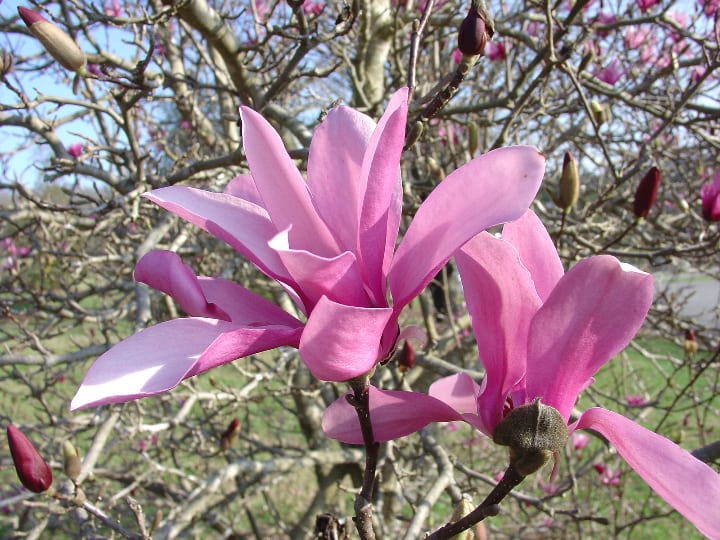
The Kobus Magnolia is a slow grower that often forms multiple trunks. It can surpass 50 ft in height.
In late fall, clustered seed pods burst out red seeds, which will attract many birds. In other words, this is a great choice if you want to have a garden full of birds.
15. Umbrella Magnolia Tree
This magnolia is named after its huge leaves, which can reach 24 inches in length. But it's the smaller, creamy white flowers that make it one of the prettiest medium-height magnolias you can find.
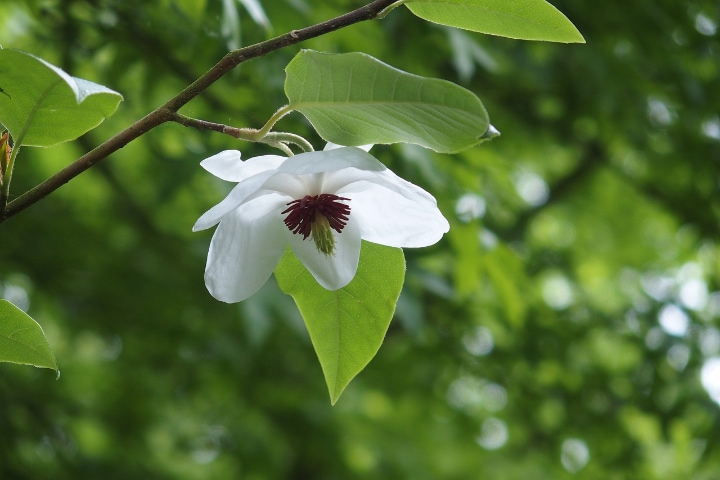
Umbrella Magnolia reaches up to 35 ft at maturity. It's one of the late-bloomer types of magnolia, the creamy-white flowers appearing in late spring.
16. Magnolia Tulip Tree
The T ulip Tree, often referred to as white or yellow poplar, is actually a type of magnolia. It thrives in moist climates but is sturdy enough to resist sub-zero temperatures in the Northern areas, as well as the hot temperatures in the South.
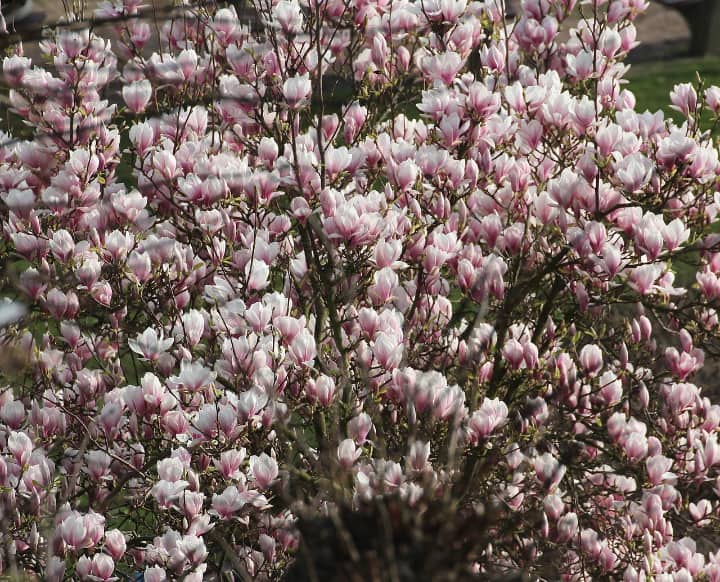
As opposed to traditional magnolia types, the Tulip tree grows up to 150 ft tall, which makes it perfect for a shade tree.
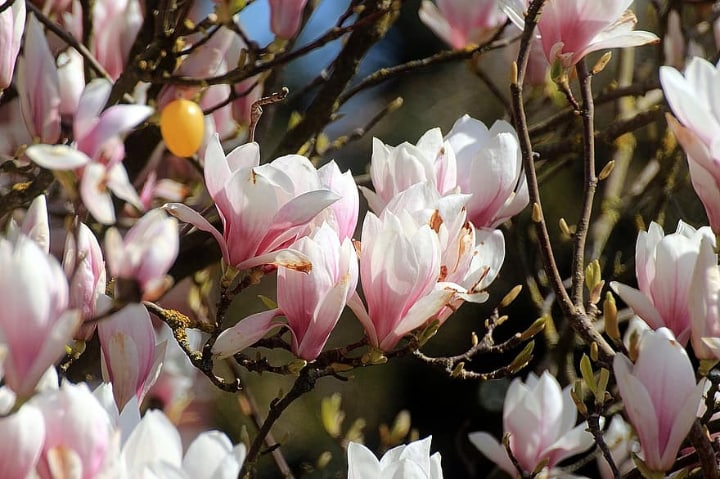
The Tulip tree's flowers, yellow with bright orange bands, grow in the upper part of the crown.
17. Bigleaf Magnolia Tree
The Bigleaf Magnolia (Magnolia macrophylla) is a deciduous species. Its name comes from the fact that its leaves are the largest simple leaves in North America.
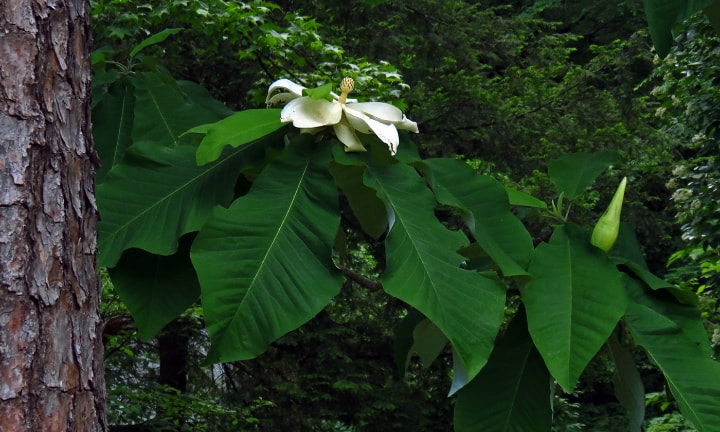
Did you know: The leaves measure up to three feet long (!) and one foot wide. Its white flowers are equally impressive, reaching up to 12 inches in diameter.
The tree grows 30–40 ft tall and 20–30 ft wide and blooms in late spring.
18. Cucumber Tree
This one's also known as Magnolia acuminata, but its popular name comes from the fruits that look like cucumbers. The Cucumber Tree grows up to 60-80 ft at maturity and is one of the types that does well even in cooler areas.
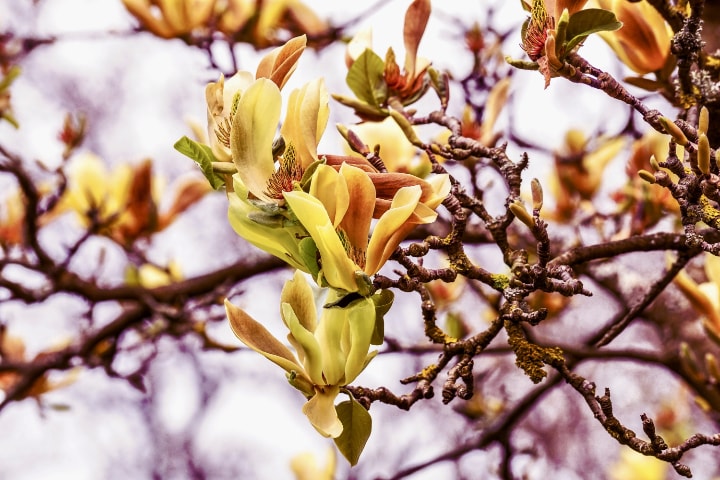
The tree has large glossy leaves, up to 10 inches long, while the flowers are more discreet, only 2 inches.
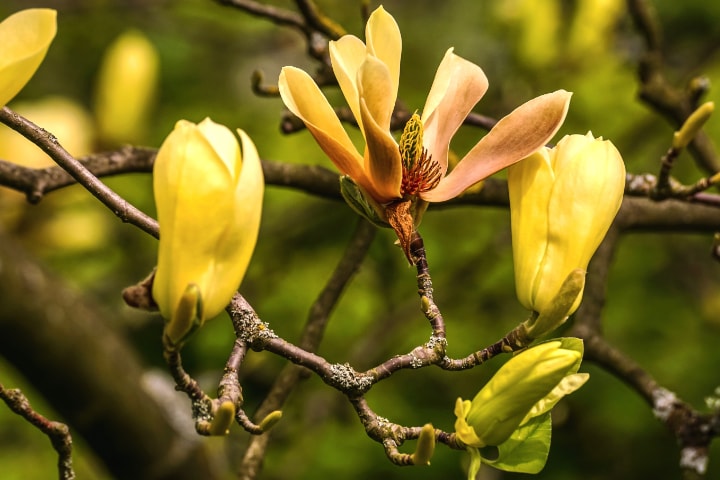
19. Southern Magnolia Tree
An imposing evergreen, the Southern magnolia is the state flower of Louisiana and Mississippi. Its white flowers appear mid-summer or early in the fall and tend to be large, just as the leaves. Unlike other magnolias, this variety likes some shade.
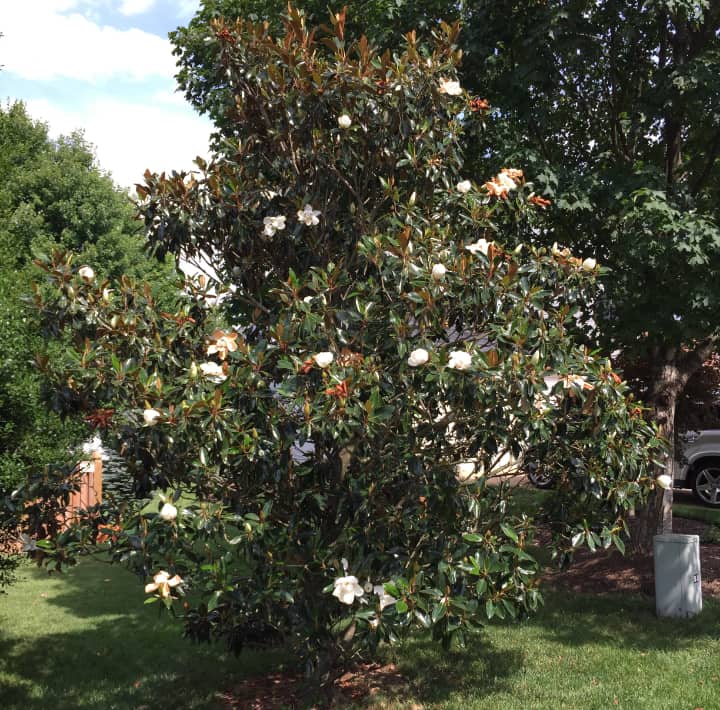
Did you know: You're looking at a type of magnolia that can reach a height of 60–80 ft and a spread of around 40 ft at maturity.
Southern Magnolia, also known as Magnolia Grandiflora, is an evergreen which means you'll have huge creamy white flowers in your garden from late May into the fall.
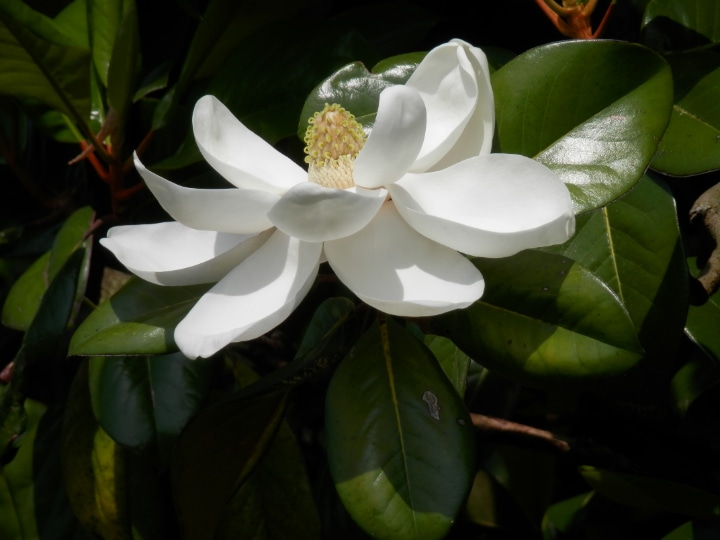
A historic Southern magnolia tree was planted in 1839 by Gen. Grandison D. Royston in the Washington State Park in Washington, Arkansas.
Some call it the Jones Magnolia because two boys not related to each other were born to Jones families nearby that same year are.
Both became Colonels in the Confederate army. Daniel W. Jones, eventually became Governor of Arkansas, while James K. Jones, became a U.S. Senator. Both laid claim to being the namesake of the tree.
20. Ashe's Magnolia Tree
This magnolia grows into a large shrub, but you can prune it into a small tree. Its fancy white flowers can grow up to 1' in length.
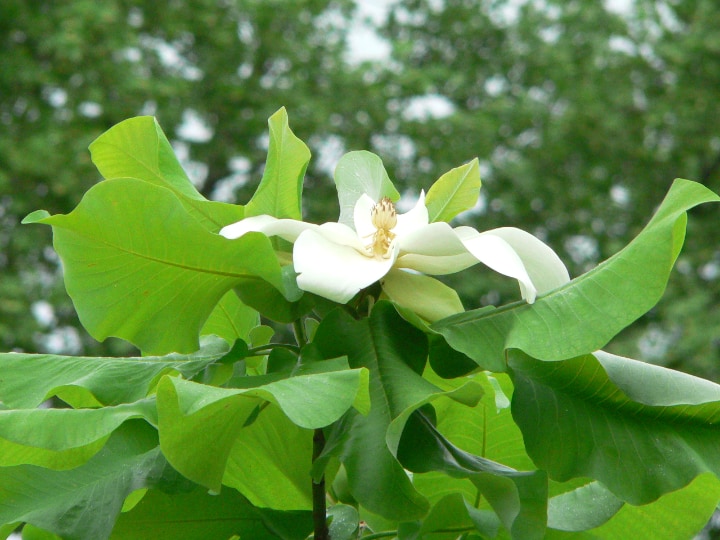
21. Chinese Magnolia (Yulan Magnolia)
Native to central and eastern China, Yulan Magnolia is a mid-size tree, reaching up to 40 ft in height and spread.
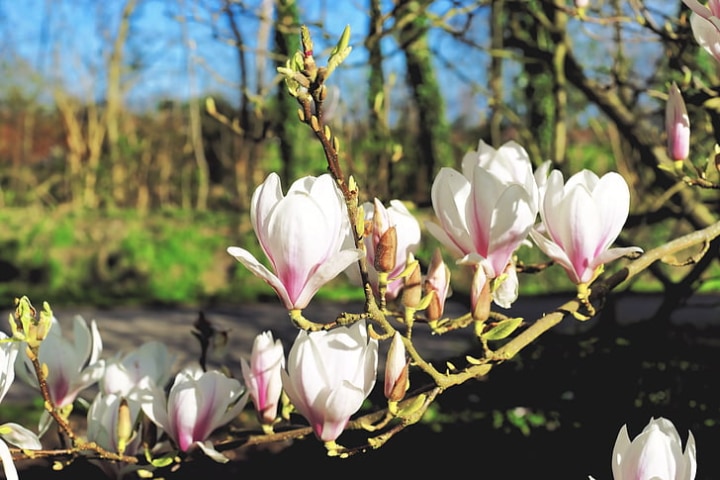
Buddhist monks regarded the Yulan Magnolia as a symbol of purity and many emperors had such trees planted in front of their palaces.
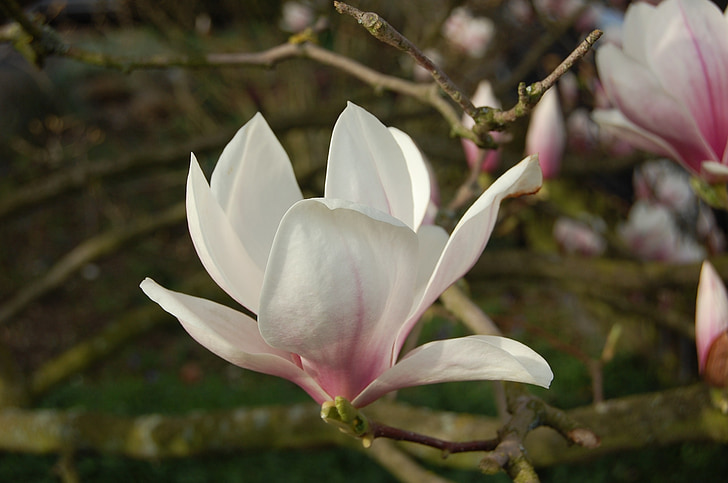
The plant is an effective air cleanser, as it can absorb toxic gases, which is why in China it is often planted as a "street tree."
22. Black Tulip Magnolia
Black Tulip Magnolia is a rare type prized for the distinctive dark purple shade of its flowers. It grows up to 20 ft tall and has a spread of 6-10 ft at maturity.
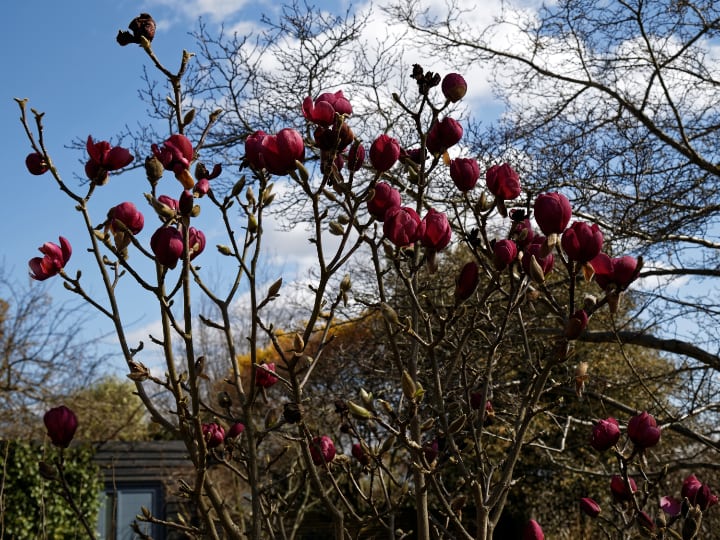
Tip: Best suited for organically-rich and slightly acidic soils. The tree thrives in a spot where it gets plenty of sun, but also partial shade during the hottest hours of the day.
How to Plant Magnolia Tree
The moment you decide you must have a magnolia in your garden you need to pick the right spot, and there are a few factors to consider—available space, sun exposure, wind conditions.
Where to Plant a Magnolia Tree?
Depending on the type of magnolia your heart is set on, look for a spot that is wide enough for it when it reaches maturity. Some species grow up to a 40 ft spread, so allow ample place for the shrub to grow.
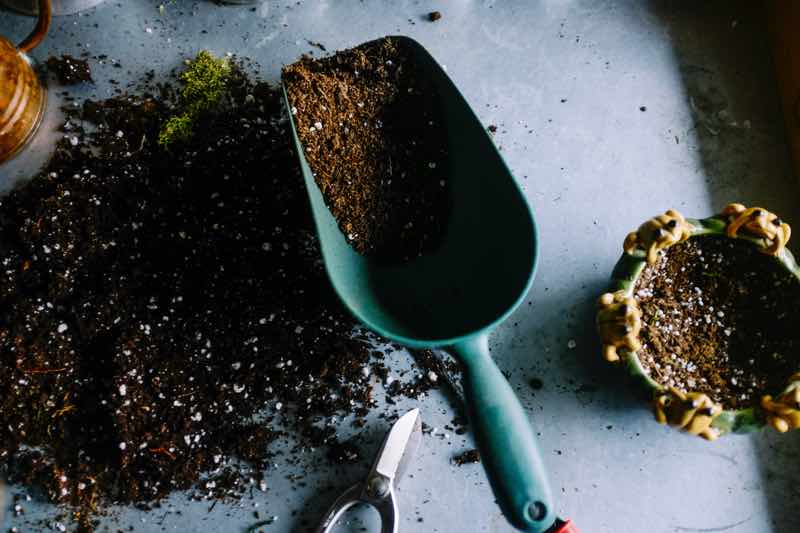
Another thing to keep in mind is that magnolia roots extend right under the surface and can be easily damaged if you start digging around.
Remember: Magnolias hate being crowded, so choose a place where you don't intend to plant anything else.
When to Plant a Magnolia Tree
The best time to plant a magnolia tree depends on the type of magnolia you have.

If your magnolia's leaves drop in the fall (deciduous tree), plant it in late fall if you live in a warm climate or in early spring if you live in a cold climate. But if you have an evergreen magnolia, plant it early in spring.
Planting a Magnolia Tree Step by Step
The planting process is the same for both evergreen and deciduous magnolias. Follow the next steps.
Step 1 – Get the Soil Ready
Dig a hole 1.5 to 2 times as wide as the magnolia ball or container but make sure it's slightly less deep than the root ball.
When you place the magnolia into the hole, the root ball should be slightly above the surrounding soil.
If you're planting into a soil rich in clay, you can further increase this height to expose up to one-quarter of the root ball.
Step 2 – Get the Plant Ready
Remove with care the upper layer of soil from the root ball or container to reveal the top root. If there are any burlap coverings, make sure to remove those, too.
For container plants, make four 1" deep, evenly spaced slices down the sides of the root ball with a shovel or knife to stimulate the growth of the root.
Step 3 – Plant It
Fill the hole with the dug-out soil and press the soil with your foot to eliminate air pockets. You can also fill the water with soil and let the water drain before adding more earth.
Step 4 – Nourish the Root Ball
Apply a thin layer of mulch over the root ball of your newly planted magnolia tree.
Step 5 – Water It
Water your magnolia 3 times a week if you live in a warm climate and 2 times a week if you live in a cold climate, starting on the planting day.
To figure out the right amount of water, measure the trunk diameter of your magnolia tree, and add 2-3 gallons for every inch.
Step 6 – Add Some More Mulch
You don't have to fertilize your magnolia at planting, but make sure to add mulch. If you're using a light mulch, add a thicker, 2" layer.
Magnolia Tree Planting Tips
- Magnolia trees prefer a spot that receives full sun to light shad e
- The best soil for magnolias is fairly rich, well-drained, and neutral to slightly acid
- Deciduous magnolias are best planted when dormant—late fall or winter in warmer climates and early spring in cold climates
- Plant e vergreen types in early spring
- C ut any roots that are circling the root ball as magnolias tend to girdle if the roots aren't spread out
- Dig a hole that is at least 1.5 times as wide as the container or the root ball
- P ut in a post next to your new magnolia and carefully tie the tree to it to stabilize it
For the first 6 to 12 months after planting, both deciduous and evergreen trees will benefit from mulch and regular irrigation during warm or dry weather.
Never planted a magnolia tree before? Check out the video below.
Magnolia Tree Planting Mistakes
- Do not cover the top of the root ball with soil
- The hole you dig should be slightly less deep than the depth of the root ball or the container your plant came in
- Do not plant in an area exposed to strong winds which might destroy the flowers or the brittle branches
- Do not fertilize your new magnolia until the next growing seaso n
- Do not plant too close to your house: magnolia roots are not invasive, but if there's a leak in your pipes the roots will be drawn to the water and might end up blocking your pipes.
How to Care for Magnolia Tree
Caring for a magnolia tree isn't hard or demanding. As we've said, magnolia trees are hardy and enduring.
Important: The thing to remember is that specific care tips apply to where you live and what type of magnolia you choose.
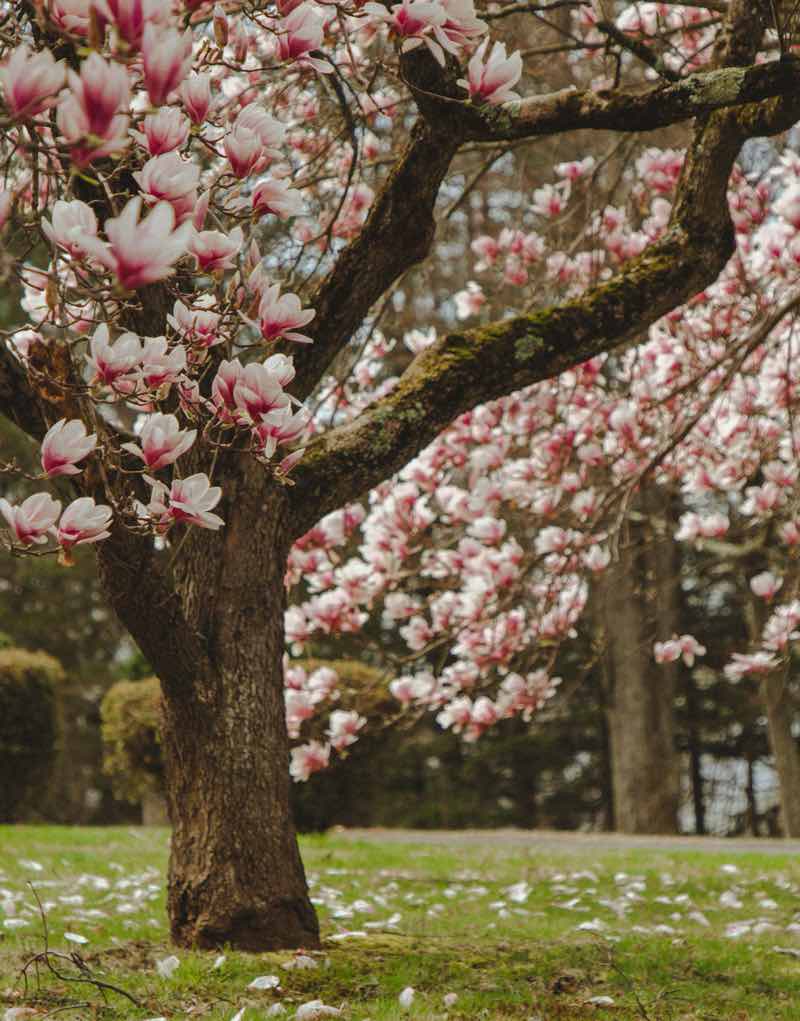
Magnolias are generally trouble-free, so your new tree will thrive if you follow a few simple rules. In this section, we'll focus on the essential tips and the most common way to take care of your tree. Let's start with the soil.
Soil
Most magnolia trees do well in slightly acidic and neutral soils but can also grow in slightly alkaline soils. What you want to avoid are very acid or very alkaline soils.
A magnolia tree can also adapt to sandy, clay, or loam soils. If you want your magnolia to grow fast, plant it in an organically rich, loamy soil.
A word of caution: a magnolia tree likes moist soil but rots easily in wet, poorly drained soils.
While you wait for your newly planted tree to establish itself in your garden, make sure to avoid soil compaction around the root zone.
Keep foot traffic around the tree to a minimum and cover the top part of the root with a thin layer of mulch.
Light
The best spot for your magnolia tree is a sunny one that's sheltered from the hot afternoon sun. Since the branches of the tree are brittle, it's best to avoid windy spots.
Don't be afraid to plant your magnolia tree where it gets full sun during the first hours of the day, provided it doesn't get burned by the afternoon sun.
Tip: Northern or eastern spots are usually best.
Water
Magnolias do not need frequent watering.
We've already talked about how often to water a newly planted magnolia tree. After the first six months, reduce watering to once a week during the growing season if temperatures are between 70-80°F.
Tip: If temperatures rise above 90°F, increase watering to two times a week.
As a rule, you should water your magnolia once a week during the first two growing seasons and twice a month after that.
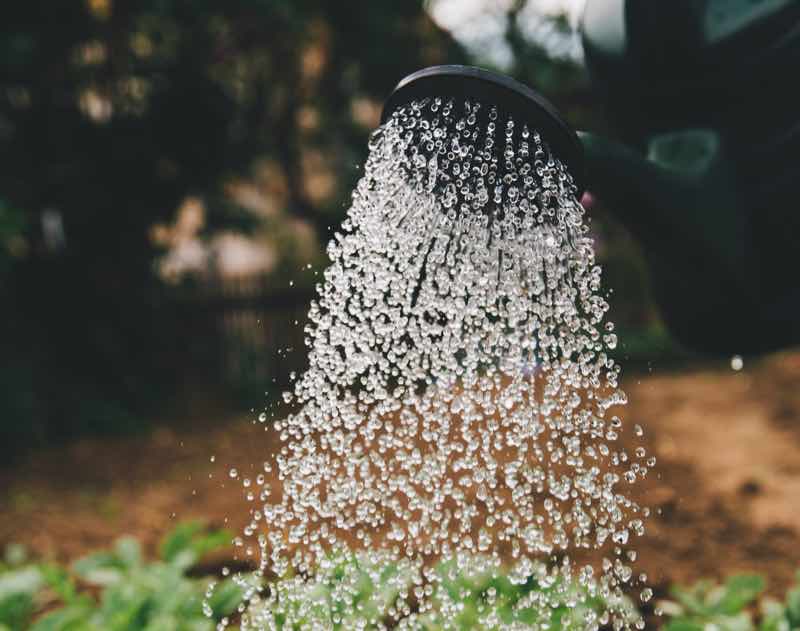
If you've planted your magnolia tree in clayey soil, focus on deep watering, and reduce the frequency of watering. Magnolias don't do well in wet soils, so avoid overwatering and ensure good drainage conditions. A layer of mulch will help keep the soil moist.
Tip: If the soil in your garden is sandy, water regularly in small amounts. Trees planted in clay soils require large amounts of water, but not very often.
Temperature
Magnolias can grow anywhere, from the cooler regions in the North to the hot areas in the deep South. Temperature shouldn't stand in your way of growing a healthy and beautiful magnolia.
Good to know: Most magnolias can handle minimum temperatures as low as 0°F (-17.8°C) once they become established.
Magnolias can adapt to most climates—after all, they're present on all continents save Antarctica. That said, deciduous, early blooming varieties are prone to damage from the cold.
If you live in a cold area, choose cold-hardy magnolia tree varieties, which are usually late bloomers or hybrids. If you experience harsh winters, you will want to protect your magnolia during the first winters.
Tip: Plant descriptions usually list the zones for which a certain type is best suited. To see in what zone you live, use this tool.
Fertilizer
The best time to fertilize deciduous magnolias is late fall after the leaves drop. For evergreen varieties, fertilize three or four weeks before the soil temperature is expected to drop below 40 degrees Fahrenheit.
Important: Use a fertilizer that contains nitrogen, phosphorous, and potassium.
Magnolia Tree Pruning

To make sure your tree has proper airflow through the branches, regularly prune dead, crossed, and overcrowded branches.
Trim young evergreen types in mid to late spring if you want to shorten long branches. You can also remove some of the lower boughs, though often, magnolia trees look fuller and more beautiful with them.
Young deciduous magnolias don't require much pruning. You just have to remove damaged branches or long vertical shoots. If you do decide to prune them, do it while they are dormant in early spring.
Tip: Magnolia trees require only light pruning now and then. While a young, growing magnolia may benefit from pruning, older specimens could sustain damage. Be careful not to over-prune your magnolias or you may hurt them.
Tips When Pruning a Magnolia Tree
- Always use sterilized shears.
- To remove a large branch, use the three-cut method.
- Remove first dead or injured branches, then branches that are crossing or rubbing, and then branches that are not in line with the tree's shape.
- Make the first cut halfway through the branch, the second approximately 13" from the branch collar, and the third outside the branch collar to remove the stub.
A general rule when pruning a young magnolia tree is to never remove more than one-third of the tree each season. Mature magnolias shouldn't be pruned except for removing injured branches.
Pests
Magnolia trees don't have much of a problem with pests. Occasionally, common pests such as scales, aphids, thrips, and caterpillars can attack the tree, but the damage won't threaten the life of your tree.
Diseases
Magnolia trees might get leaf spots, bacterial blight, and verticillium wilt. Such diseases cannot be controlled with chemicals so prevention is the best defense.
Important: To prevent fungal and bacterial diseases, regularly remove all plant matter that has fallen from the tree to the ground below.
Magnolia Trees for Sale
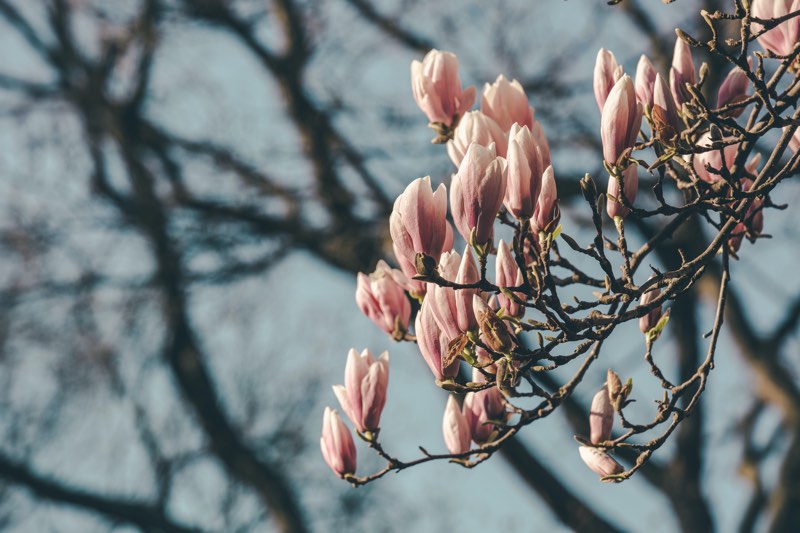
Looking to buy a magnolia tree? You can buy a young single stem tree or a mature tree. Some magnolias are also sold as small bushes.
Single stem trees and small bushes tend to be the most affordable. Even more affordable are magnolia seeds, which often come at a fraction of the price of a young tree.
Did you know: Magnolia seeds for sale have usually gone through cold storage, which means that you can seed them at any time of the year. Germination may take 6 weeks or longer, depending on the type of the seeds.
How to Buy a Magnolia Tree
Magnolia trees and seeds are available online as well as in local stores. Buying online can help you save money and gives you more options to choose from.
But if you shop for trees online, you can't really inspect them until after delivery, so you may want to make sure that you get a money-back guarantee just in case.
Here are some tips to keep in mind when buying a magnolia tree in-store:
- Buy plants with evenly spaced branches.
- Slip the plant out of its pot to check the roots—healthy roots are white, not brown or discolored.
- Avoid plants with discolored leaves or stems.
- Avoid magnolias with crossing, rubbing, or broken branches.
- Look out for wounds on the main trunk.
Tip: Keep in mind that circling roots in the pot could mean that the plant is rootbound, which isn't ideal.
So, if you're looking for a magnolia to buy, check out our handpicked recommendations! There are over 210 magnolia plant species out there. Remember that your choice as a gardener is ultimately limited by the region you live in.
Little Gem

All the splendor of a Southern Magnolia in a smaller size, perfect for every type of garden. You can use it to decorate your patio or plant it.
CHECK PRICE
Bracken's Brown Beauty

One of the most beautiful cultivars of the Southern Magnolia, this is a fast-growing evergreen type that can easily tolerate lower temperatures.
CHECK PRICE
Southern Magnolia

One of the most popular magnolia types, guaranteed to give you sweet fragrant flowers from early spring to summer. It's an evergreen plant so you'll have a beautiful green tree in your garden all year round.
CHECK PRICE
Magnolia Tree FAQ
As a recap, we've added the most Frequently Asked Question about growing and taking care of a Magnolia Tree below.
Do you still have a question that isn't answered in the FAQ, please contact us or leave a comment and we'll get back to you as soon as possible!
How fast growing is a magnolia tree?
The growth rate of your magnolia depends on its type and growing conditions. Southern Magnolia grows from 1 ft to 2 ft per year, which is a slow-to-medium rate. Fast-growing trees shoot up 24 inches per year. Some fast-growing magnolia types include the Cucumber Magnolia or cultivars of the Southern Magnolia, such as 'Margaret Davis' and 'Smith Fogle'.
Where do magnolia trees grow best?
Magnolia trees grow best in sunny spots protected from the hot afternoon sun, in slightly acidic, well-drained soil. Magnolias can adapt to most climates—they're present on all continents except Antarctica. That said, deciduous, early blooming varieties will likely get damaged from the cold. Check out the characteristics of each type of magnolia before picking out one for your garden.
Which magnolia tree is best?
There is no such thing as a bad magnolia, all magnolias are beautiful. Some types are more popular, like Southern Magnolia or Star Magnolia, but you might want a more rare plant for your garden, like a yellow cultivar.
When should I buy a magnolia tree?
Buy a magnolia right before planting. Evergreen magnolias must be planted in early spring. As for deciduous magnolias, that depends on the climate in your area. In the Northern part of the US, deciduous magnolias should be planted in the fall, while in the South, it's recommended to plant them during spring.
How much do magnolia trees cost?
Magnolia trees are more expensive than most other garden trees, but exact prices vary widely depending on the variety you choose. Very small magnolia trees can cost as little as $25. Magnolia seeds are cheaper. Find out what to look out for when buying a magnolia tree.
Do magnolia trees need sun or shade?
Magnolia trees need full sun to light shade. In warmer climates, it's best to avoid exposing them to the hot afternoon sun. Northern or eastern spots are usually best. Read on about how to care for a magnolia tree.
How quickly does a magnolia tree grow?
Different species of magnolia trees can range in size from 15' to 80' in height and reach widths of up to 40'. Magnolia trees need between 10 and 30 years to reach this mature height. Magnolias can grow 1-2' in a year.
If You Don't Have a Magnolia Tree Yet… It's Time to Plant One!
Exquisitely beautiful and remarkably adaptable, magnolia trees can a special touch to any yard or garden.
While you do have to plant them in the right spot and avoid overwatering them, magnolia trees require little maintenance and aren't as pretentious as some people think.
Is there one type of magnolia that you find most attractive? Choosing the perfect magnolia for your garden is not easy, as they're all gorgeous.
Before looking at the flowers and their many shades, take a moment to consider just how much space you have in your garden and, most importantly, the weather in your area.
The important thing is to choose the right magnolia for your region and check specific care instructions for it.

If your heart is set on a specific magnolia, look up a cultivar designed to thrive in the climate you live in. There should be plenty to choose from!
Whichever you choose, you'll be rewarded for your efforts with a beautiful tree with fragrant leaves and aromatic twigs and branches that can become the pride of your garden. Grow your own magnolia flowers now!
PS: After you plant your magnolia tree, come back and tells us all about it. We'd love to learn about it!
Decorating Magnolia Tree For Christmas
Source: https://www.plantedwell.com/magnolia-trees/
Posted by: castillopairame.blogspot.com

0 Response to "Decorating Magnolia Tree For Christmas"
Post a Comment